Piotr Naskrecki's Blog, page 9
April 8, 2013
Mozambique Diary: Sylvan katydids of Gorongosa

Male Elegant sylvan katydid (Acauloplax exigua) in his typical resting position.
A few nights ago, as I was walking towards my cabin along the edge of the Chitengo Camp, I heard a call of a cricket that I did not quite recognize. Cricket calls are unmistakable for their clean, almost melodious quality, very different from the call of a cicada or a katydid, which tend to be more “noisy.” But his call was very pure, almost bird-like, and it was coming from high in a tree. I expected to find a black, wide-winged Homoeogryllus cricket among the leaves, but to my delight the mystery caller turned out to be a gorgeous Blue-legged sylvan katydid (Zabalius ophthalmicus). This and a few related species produce some of the most pure tone, almost whistle-like calls, a rarity among katydids.
Sylvan katydids (Pseudophyllinae) are uncommon in this part of the continent. The greatest diversity of these insects is found in the rainforests of Central and West Africa, where most live high in the canopy. In Mozambique I expected to find only four species, and indeed found them all in Gorongosa (which of course is not to say that more are not to be discovered.) Virtually all sylvan katydids, true to their common name, are associated with forests and other woody habitats, and few are found in the open savanna.
Southern African sylvan katydids display two very distinct types of mimesis (camouflage). Species found in the canopy of broad-leaved trees (e.g., Ficus) are superb mimics of foliage, complete with leaf-like venation of their wings and fake fungal spots or other “damage.” During the day they rest with their wings spread flat against the lower surface of the leaf, and are absolutely impossible to find. (Interestingly, this type of behavior does not occur in any katydid species found in the New World – all North and South American katydids hold their wings in a vertical position, and during the day rest on twigs with their wings facing up in an imitation of a small leaf.)

Greater bark katydid (Cymatomerella spilophora) in the woodland of Gorongosa
The second group of species of Mozambican sylvan katydids are bark mimics. These species are associated with more open habitats, mostly miombo or mopane woodland, and spend the day resting on trunks of small-leaved trees, such as Acacia or Brachystegia. Their wings are held similarly flat against the bark, and their coloration is mottled, resembling the surface of the trunk. In addition, their legs are strongly flattened and covered with dense hairs, which helps them eliminate shadow cast by their bodies.
One of the Mozambican species, The Common bark katydid (Cymatomera denticollis), is unusual among katydids in its ability to produce chemical defenses. Production of repellant chemicals has been documented in a few Neotropical species, but this is the first example of such a behavior in an African species. These insects, when threatened by a predator, fan their wings and reveal a brightly colored, red, orange, and black abdomen. At the same time a gland on their abdomen sprays a strongly smelling liquid. I have had no chance to look into the chemical composition of this substance, but it smell is very much reminiscent of that produced by their (unrelated) South American counterparts. In those katydids the repellant substances were identified as methylpyrazines, and I would not be surprised if the African species produced related compounds.

A song of the Blue-legged sylvan katydid (Zabalius ophthalmicus). Click here to listen to the recording: first played at the normal speed, followed by a fragment slowed down by a factor of 10 (for the katydid-challenged listeners, i.e., most males over 35).

Female Elegant sylvan katydid, showing fake leaf damage and leaf-like venation on her wings.

Sylvan katydids of Gorongosa in their typical daily resting poses: Blue-legged sylvan katydid (Zabalius ophthalmicus), Elegant sylvan katydid (Acauloplax exigua), Common bark katydid (Cymatomera denticollis) and Greater bark katydid (Cymatomerella spilophora).
Filed under: Behavior, Gorongosa, Katydids, Mozambique


April 5, 2013
Mozambique Diary: Manticora
A male Monster Tiger Beetle (Manticora latipennis) killing one of his favorite prey items, a grasshopper (Humbe tenuicornis) [Canon 7D, Canon 100mm macro, 3 x Canon 580EXII]
Things have been busy here in Chitengo, and I am struggling to find time to update the blog amidst the preparations to our upcoming biodiversity survey of the Cheringoma Plateau. But I simply cannot resist mentioning one of the most remarkable creatures that I have had the pleasure to meet in Gorongosa. Every biologist has a list of organisms that he or she is particularly keen on seeing at least once in the wild. My list is long, but a few days ago I managed to check off it Manticora, or the Monster Tiger Beetle.With a name like this one would expect a rather extraordinary beetle, and one would not be disappointed. Named after a mythical beast with the body of a lion, head of a man, and the tail of a scorpion, the real-life Manticora may not be as monstrous, but it is nonetheless a stunning animal. It is the world’s largest tiger beetle (Cicindelinae), with a robust, heavily sclerotized body that easily reaches 65 mm in length. Its head, especially that of the male, is equipped with a pair of mandibles that would not look out of place on a stag beetle but, unlike the mostly ritualistic function of large mandibles in stag beetles, those of Maticora are very much functional.
The mandibles of a male Manticora latipennis are truly impressive. In addition to catching and killing prey, males use them hold and guard a female during copulation. [Canon 6D, Canon 16-35mm + an extender, 3 x Canon 580EXII]
Despite its size Manticora behaves in a way quite similar to smaller tiger beetle species. Its movements are agile, and it can run like hell and change direction in a split of a second; they cannot fly, however. These beetles hunt anything that moves, although prefer orthopterans, but unlike other tiger beetles it appears that the sense of smell rather than vision is their main tool for locating their victims. Once prey is located the beetle clasps it with its enormous mandibles and literally chops it to pieces. I watched it find and kill a large wolf spider – at first I thought that the spider would put up a fight, but about two seconds later what was left of the spider was a nicely masticated ball of tissue and a small pile of legs. After the main body was consumed the beetle picked the legs, one by one, off the ground and ate them, too. Interestingly, the beetle, which was a male and thus his mandibles ware particularly large, used its maxillae rather than the mandibles to pick up the leftover bits of prey, a behavior I have not seen before in a beetle.A spider found by Manticora did not stand a chance – in a couple of seconds all that was left of the animal was a pile of body parts. [Canon 6D, Canon 16-35mm + an extender, Canon MT-24EX twin light]
Manticoras have a bimodal pattern of activity, hunting mostly early in the morning, and then again around sunset and, contrary to a frequently repeated misconception, they are not nocturnal. This is likely because of the competition from other, mostly nocturnal ground beetles (Anthia and Termophilum), which are also common here.A male Manticora with prey [Canon 7D, Canon 100mm macro, 3 x Canon 580EXII]
The discovery of Manticora in Gorongosa has also solved a small mystery for me. About a week ago I witnessed a strange sight – a very large antlion of the genus Palpares, an insect the size of a small bird, was slowly disappearing, head first, into a perfectly round hole in the ground. That just did not compute, and I had to see what was causing this behavior. I tried to pull the antlion out and something pulled back. But the mystery animal’s strength was no match for my mighty human strength, and I freed the antlion, but not before catching a glimpse of a large, flat head about the size and shape of a penny, disappearing deep into the perfectly vertical tunnel in the ground. Tiger beetles have larvae that behave in exactly this way, and now I am convinced that I stole the prey from a Manticora larva. Next time I see a similar tunnel I will try to find the larva and photograph it.I have read in several places that the male Mantcora’s enormous mandibles are not good at catching prey – not true, they are excellent killing devices! [Canon 6D, Canon 16-35mm + an extender, 3 x Canon 580EXII]
Filed under: Beetles, Behavior, Gorongosa, Mozambique


March 31, 2013
Mozambique Diary: A talking grasshopper
A male Cataloipus cognatus munching on grass. [Canon 6D, Canon 100mm macro, 3 x Canon 580EXII]
One of the most endearing characteristics of grasshoppers is their ability to produce sound. Some of the most wonderful memories of my childhood include sitting in a meadow bursting with sounds of insects and watching grasshoppers use their hind legs to produce soft, rhythmical songs, and not realizing that a seed that would eventually blossom into a full-blown career in entomology is sprouting in my brain.Despite the strangely persistent misconception, the sound of grasshoppers is not produced by rubbing their legs together (in fact, no insect makes sound in this way), but rather by dragging the inner side of the hind femur against a thick vein on the front wing (depending on the group, either the femur or the vein is armed with a row of stridulatory pegs). But this ability to produce loud songs is far less common among grasshoppers than it may appear to somebody who grew up in Europe, one of the few places in the world where members of the vociferous subfamily Gomphocerinae dominate the grasshopper fauna. I was surprised how few grasshoppers sing in North American or Australian meadows, and tropical grasshoppers of South America and Africa are almost all silent.
Females of C. cognatus are much larger than the males; they are also completely silent, whereas males produce a loud mandibular stridulation. [Canon 6D, Canon 100mm macro, 3 x Canon 580EXII]
I was therefore quite startled when I caught yesterday in Gorongosa a beautiful grasshopper Cataloipus cognatus, and the insect responded to this violation of its freedom by producing loud and persistent squeaks. It took me a while to discover how the sound was produced. At first I thought that it was using its hind legs to make the sound, but this lineage of grasshoppers (Eyprepocnemidinae) lacks stridulatory pegs on their legs, and besides, I was holding it by the legs and thus it couldn’t use them even if it wanted to. Looking closely I realized that the grasshopper’s sound was coming from its mouth. I knew of a katydid species that was capable of stridulating with its mandibles, but had no idea that some grasshoppers could also do it.Just to be sure I caught a few more individuals, and some made the sound while others didn’t. Then I noticed that the silent ones were all females, while all males were producing the sound. Since I don’t have a microscope here in the Chitengo camp (yet, one is coming soon, fingers crossed), I could not look at the structure of the sound-producing apparatus. But I recorded the sound and looked at its oscillogram, which revealed a clean, evenly spaced pattern of pulses, which is indicative of the presence of a distinct stridulatory file. This, combined with the fact that only males produce sound, seems to suggest that the sound might be used not only as a defensive signal, but rather that it may play a role in courtship. If this true, and I will try to confirm it by watching the courtship behavior of this species, it would make a very interesting case of independent evolution of courtship stridulation in eyprepocnemidine grasshoppers.

An oscillogram of the mandibular stridulation of C. cognatus; click here to listen to the sound.
Filed under: Behavior, Gorongosa, Macrophotography, Mozambique, Orthoptera


March 30, 2013
Mozambique Diary: Playing a detective
Mysterious larvae in a tree cavity in Gorongosa. [Canon 6D, Canon 100mm macro, Canon MT 24EX twin light]
For an entomologist few pleasures in life are greater than arriving in a new geographic area and being stumped by unfamiliar and mysterious insects, often ones that he/she had never suspected existed. I had a moment like this last night, when I ran across a strange, metallic blue insect, about 25 mm long, walking on the sand in Chitengo. My first thought was that it must be a blattodean, some of which are wingless and have a dark, metallic sheen. But when I picked it up I realized that it was a beetle larva. I knew it because the insect lacked well-developed tarsi or any traces of wings or wing pads, and its antennae consisted of only two articles (although one was exceptionally long). But what family? Ground beetles (Carabidae) often have strange, active larvae that hunt insects in sandy areas, and this was my guess.Then I happened to look up at the trunk of a nearby tree and saw several dozens of these larvae huddled in a small cavity about 2 m above the ground; the one I found must have fallen off the tree and was trying to find its way back home. I concluded that it couldn’t be a carabid as their larvae are ground-dwelling predators and thus unlikely to (a) live high in the trees and (b) form large aggregations.
A cluster of pupae in a tree cavity. [Canon 6D, Canon 100mm macro, illuminated with a headlamp]
A few meters away another tree had a second colony of these insects, but this one was a little older. Although it still had a few larvae moving around, most had already metamorphosed into pupae, which were hanging in grape-like clusters, eerily reminiscent of a scene from the movie “Alien”. There were about 50 of them hanging together, but the tree cavity was very deep and narrow, and I couldn’t get a good photo of the group. I had never seen beetle pupae hanging in a similar formation. The mystery deepened.I shone a light into the cavity and squeezed my hand in to scoop one of the pupae. At that moment I noticed two adult beetles, which seemed to be guarding the cluster. They were clearly a male and a female since one individual was slightly larger and had distinctly thickened front legs with a pair of large spines; I assumed that it was the male. Both beetles ran away when I put my hand in, but quickly returned and assumed the same position near the clutch of pupae.
And they were darkling beetles, or Tenebrionidae! One of the first things you learn in an entomology class is that tenebrionids have elongate, vermiform larvae that burrow in the ground, and for this reason it never crossed my mind that the blue, free-running larvae in the tree might belong to this family. A cursory search of coleopterological literature revealed that my beetles may be members of a large, nearly cosmopolitan genus Strongylium, of which some species are arboreal. If any any entomologist reading this has another idea, I would love to know it – being stumped by an unknown insect is a pleasure, but never learning its identity is torture.
[image error]
Three developmental stages of a mystery beetle, found together in the same tree “colony”, tentatively identified as Strongylium sp. (Tenebrionidae). [Canon 6D, Canon 100mm macro, 3 x Canon 580EXII]
Filed under: Beetles, Behavior, Gorongosa, Mozambique


March 29, 2013
Mozambique Diary: It’s good to have my gear back
To celebrate the miraculous recovery of my photographic equipment from the clutches of South African Airways, today I took my new Canon 400mm for a short spin around the Chitengo camp. I usually do not photograph birds and mammals, but there are so many of them around that it would be a shame not to point a lens at some.
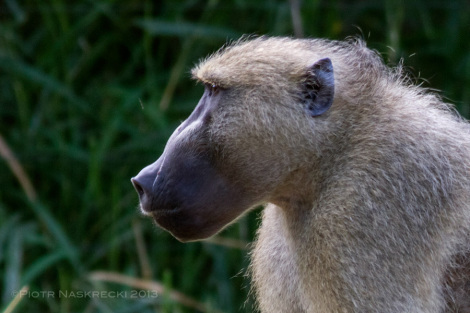
This Yellow baboon (Papio cynocephalus) got in our cabin this morning and stole our bananas. Just a reminder to keep our doors and windows locked, we are on their turf here.
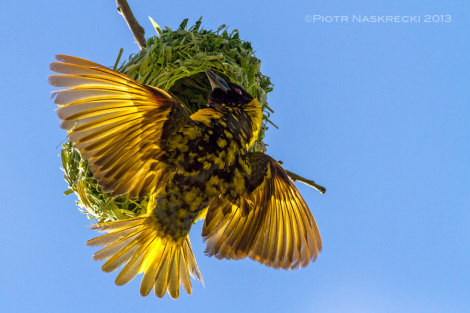
There is a small colony of Village Weavers (Ploceus cucullatus) near my cabin. This male was finishing his nest and frequently displayed if any female was around.

African Pied Crow (Corvus albus) is a handsome, intelligent bird, but for some reason birders tend to ignore this species.
Filed under: Birds, Gorongosa, Mammals, Mozambique


March 27, 2013
Mozambique Diary: The real birds-of-paradise
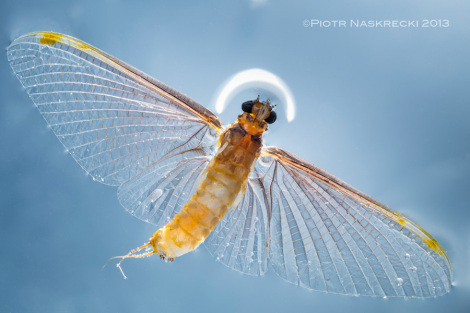
Once an adult male burrowing mayfly lands on the the surface of the water it dies within a few minutes. (The angel-like halo around this insect’s head is a reflection of my flash, which normally I would not tolerate, but in this case it seems appropriate.)
Early Portuguese and Spanish explorers who visited the island of New Guinea in the 16th century were astounded by magnificent, brilliantly colored birds, whose plumage was used by the locals to adorn their headgear and bodies. European naturalists who examined skins of these birds brought back from New Guinea noticed that all specimens lacked legs, and concluded that the birds must have spent their entire life hovering above the ground, akin to angels, and never needed to walk or stand on solid ground. Even Linnaeus was not entirely immune to these legends, and named one of the species Paradisaea apoda, or The Legless Bird-of-Paradise. How silly! Surely, there cannot be an animal that spends its entire life in flight without touching the ground. Or can it?
Yesterday we had a pretty rainy day in Chitengo, which made a lot of insects very happy, including clouds of termites emerging from their underground nests and flying in search of mates. Among the many insect species coming to lights around the camp were strange flying creatures which, once they hit the ground, could never lift off again. At first I thought that those insects must have been injured, but when I picked one up I noticed that the insect, despite having two pairs of large wings, didn’t have functional legs.
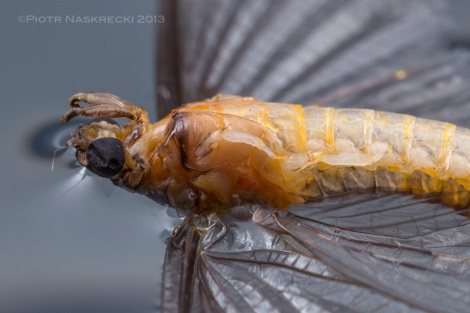
Legs of burrwing mayflies (Polymitarcyidae) are reduced to useless stubs and are completely non-functional. Males’ front legs are slightly larger and may by used during mating, which also takes place in the air.
These strange animals turned out to be burrowing mayflies of the family Polymitarcyidae. As larvae these insects develop by digging in the mud of streams and, after completing their aquatic development, winged adults leave the water looking for love. But once in the air, they can never land again. Their legs, especially those of males, are completely atrophied, and cannot be used for walking or even standing. The few short hours that the male mayflies spend as adult insects take place entirely in the air – if they land, they die.
Legless birds-of-paradise from New Guinea turned out to be a fraud, but animals that spend their entire adult life in the air are very real. They may not be as colorful as the birds, but this does not make them any less fascinating.
P.S. Nearly two weeks later after losing a Pelican case with my photo equipment on a flight to Johannesburg I was today reunited with my luggage, which makes me very happy.
Filed under: Behavior, Ephemeroptera, Gorongosa, Mozambique


March 26, 2013
Mozambique Diary: A reversal of fortune
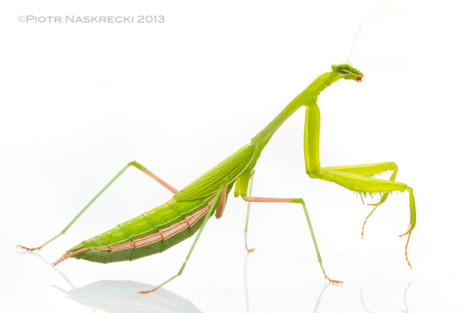
Miomantis is a large genus of small, delicately built praying mantids, with about 75 species known from across Africa. Females, like this individual, are usually short winged, while males are fully winged and are excellent fliers.
Gorongosa National Park is heaven for praying mantids – nowhere else in the world have I seen so many different species or similarly high abundance of these insects. This appears to be a good indicator of the overall condition of this ecosystem, with almost unlimited availability of prey. Usually this means grasshoppers and other insects, but occasionally arachnids and even small lizards fall prey to some of the mantids.
Last night I was walking along a path in the camp and noticed a small praying mantis of the genus Miomantis getting ready to catch a fat green spider that was beginning to spin a web by one of the lights that illuminated the pathway. These mantids are no longer than a half of your pinky finger and delicate in their built, and usually feed only on small flying insects. But this female was clearly very hungry. She struck the spider and caught it in her raptorial front legs. “Good for you”, I thought, “this will be enough food to produce several clutches of eggs.”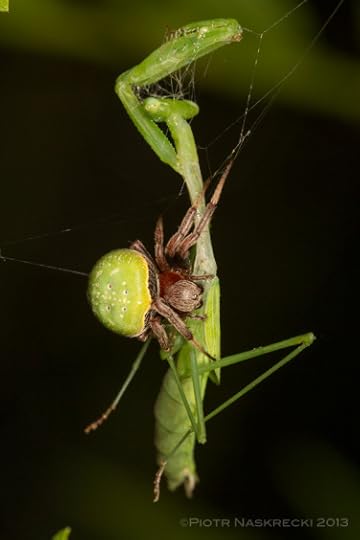
This poor mantis clearly overestimated her hunting abilities – the spider she had caught not only managed to escape her grip, but also killed and eventually ate most of her.
I decided to take a photo of this feat and ran to get my camera. But when I came back I saw that the situation had turned tragic for the huntress – the spider had managed to free itself from her clutches, bit her, and was quickly spinning strands of silk around her. The spider was slightly injured, too, as evidenced by droplets of hemolymph oozing from several points on its body but, in the end, it won fair and square.
Filed under: Behavior, Gorongosa, Mozambique, Praying mantids


March 25, 2013
Mozambique Diary: The Marbled half-piglet
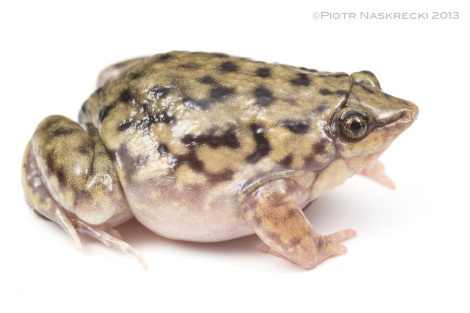
Although officially known as the Shovel-nosed frog (Hemisus marmoratus), I think you will agree that a direct translation of its scientific name, the Marbled half-piglet, is more appropriate.
Walking around the Chitengo Camp in Gorongosa, especially after the rain when the earth is soft, I often run into two types of cute, pig-like creatures. Warthogs are the more noticeable ones, digging around for roots and grubs, completely unafraid of the busy activity of the preparations for the opening of the tourist season. But if I look carefully at the ground under my feet I often see what appears to be another kind of a tiny, fat piglet. These are Shovel-nosed frogs (Hemisus marmoratus), a species of subterranean amphibians that are remarkably adept at digging into the soil. A closer look reveals the root of their scientific name (“hemi-” means “half” in Greek and “sus” is “a pig” in Latin) – their pudgy little body ends in a sharp snout and, unlike other burrowing frogs that dig with their hind feet, these dive in head first, using the snout as a wedge and their short legs to push the body underground. They are not great jumpers and so they prefer to run if scared, and as soon as they find a suitable patch of soil they start pushing the potbellied body into the earth. If the soil is soft they completely disappear in a matter of seconds.
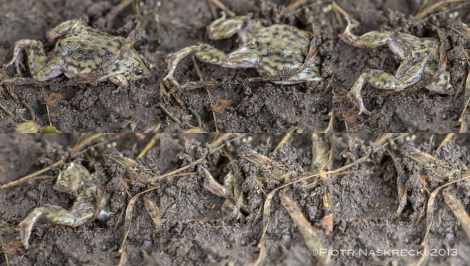
The preferred mode of escape of the Shovel-nosed frog is to disappear underground. Their pointy snout and powerful hind legs allow them to dig in completely in only a few seconds.
Often, however, the ground is too hard to dig, and the only choice is to stand their ground. Already quite portly, they gulp in air and inflate the body, turning it into a small balloon, and making it difficult to swallow by a snake or another predator.
The Shovel-nosed frogs feed mostly on termites and ants, which explains their exceptionally small mouth, but it is not clear whether they are able to feed underground or only on the surface. Their reproductive biology is quite interesting – rather than laying eggs directly in the water, the female lays them in a burrow a few weeks before the onset of rains, and waits for the wet season to come. During this time she defends the eggs and newly hatched tadpoles against ants and other predators. If the conditions allow she then digs a connecting channel to a larger pond where the tadpoles complete their development, or carries them there on her back. This strategy gives the tadpoles an edge over other species because they enter the water and begin feeding before the eggs of other frogs have a chance to hatch.
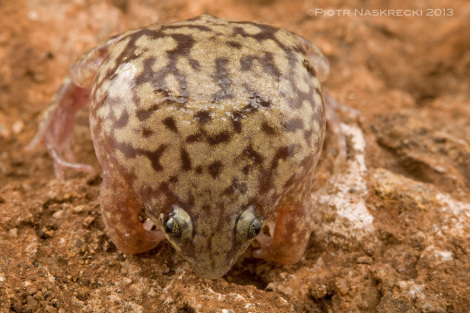
If unable to dig, the Shovel-nosed frog inflates its body, making itself difficult to swallow.
Update: Yesterday I wrote about a search for the world’s largest orb-weaving spider, which appears to occur in Gorongosa. Alas, after a long search Matjaž and Ingi were not able to find it. I will continue looking and let you know as soon as I find it.
Filed under: Amphibians, Behavior, Frogs, Gorongosa, Mozambique


March 24, 2013
Mozambique Diary: The stuff of dreams
Banded-legged golden orb weaver (Nephila senegalensis) from Gorongosa [Canon 7D, Canon 14mm, Canon MT 24EX twin light]
Isn’t it fascinating that the same thing can be the subject of one person’s worst nightmares, and another person’s wildest dreams and desires? Nothing illustrates this point better than the Golden orb spiders (Nephila), which my wife doesn’t even call spiders – they are simply her Nemesis, clearly intent on luring her into their enormous webs and tangling themselves into her hair.But today I had the pleasure of going into the field with two great arachnologists, Matjaž Kuntner and Ingi Agnarsson, who came to Mozambique with one dream and one dream only – to see and catch the largest orb weaving spider in the world, Nephila komaci. This species was discovered by Matjaž a few years ago among old museum specimens, but nobody has seen a live individual since. But there is an interesting twist to this story – the reason Matjaž and Ingi chose Gorongosa to look for this Holy Grail of arachnology was a small photo, a thumbnail really, of N. komaci that had appeared on the old Gorongosa’s website five years ago, two years before the species was officially described. We didn’t know where exactly the photo had been taken, but it had to be somewhere in the park.
We set out early in the morning to look for the elusive weaver, hoping that we might find it in the patches of sand forest in the southern part of the park. Alas, after several ours of trampling through the bush we came back empty handed, not in small part because of some confusion as to where the forest was, which made us end up miles away from our intended destination. But playing bait for lions for several hours this morning was not a complete loss, either. The spider men found a few interesting species, including a related species, the Banded-legged golden orb weaver (Nephila senegalensis). These are gorgeous beasts, huge and beautifully colored. Their orbs are often made of brightly yellow silk, hence the common name. A few years ago Simon Peers and Nicholas Godley used the silk of a related species from Madagascar to weave an extraordinary golden cape.
Tomorrow Matjaž and Ingi will continue their search, this time with a GPS and an even stronger desire to lay their hands on the dreamy arachnid.
Filed under: Arachnida, Gorongosa, Mozambique, Wide angle


March 23, 2013
Mozambique Diary: It is loud out here
A male Tobacco cricket (Brachytrupes membranaceus) singing at the entrance to his burrow. The shape of the opening acts as an amplifier to his already very loud song. [Canon 7D, Canon 16-35mm, Canon MT 24EX twin light]
I am back from the first reconnaissance trip to the Cheringoma Plateau in the eastern part of Gorongosa. It was slow going and in nearly all places we were forced to do a lot of road clearing, removing or finding a way around fallen trees, but the rewards were great. The eastern part of the park is one of the most gorgeous areas I have ever been to, full of deep gorges and canyons, waterfalls, and beautiful forests. During this trip I did not have much time to look for insects, hardly any in fact, but one species was rather difficult not to notice.We spent the last night of the recon in a remote outpost of park rangers, a place that happened to sit on top of deep, sandy soils. And such soils are just what the Tobacco crickets (Brachytrupes membranaceus) love, and they make it loud and clear. At around 7:30 pm, just after it got really dark, the entire camp suddenly erupted in incredibly loud, buzzing racket when about a dozen cricket males started singing at the entrances to their burrows. They were very easy to locate, but getting too close to one was painful. Listening to a singing Tobacco cricket from a distance of a meter or less is akin to staring into a bright lightbulb – for a while, once you turn your eyes away, you still see the light and not much more, and the cricket’s song leaves your hearing similarly dulled and almost unable to perceive any other sounds for a few seconds.
Singing males always face the burrow and dive in at the slightest disturbance. [Canon 7D, Canon 16-35mm, Canon MT 24EX twin light]
This of course is not surprising, considering that this species is the size of a small mouse. Tobacco crickets are giants, reputedly the largest species of crickets in the world (but there are several related species in Asia, which are similarly huge). They also appear to be the loudest. I recorded one of the males and you can listen it here: to get the most life-like impression of this sound, crank up the volume of your computer to its maximum setting and place your ear near the speaker.Tobacco crickets get their name from their preference for young tobacco plants, and in some areas of Africa they are considered pests. Unlike most crickets and other orthopterans, these insects gather and store food in their burrows, and are able to preserve it so that mold does not destroy it. They are also unusual in a well-developed maternal care. The female, which has a strongly reduced ovipositor, lays the eggs in her burrow and cares for them and the newly hatched nymphs until they are ready to forage on their own. All in all fascinating creatures, which also taught me to look for large holes in the ground before setting up a tent, and move as far away from them as possible.
Filed under: Behavior, Gorongosa, Macrophotography, Orthoptera


Piotr Naskrecki's Blog
- Piotr Naskrecki's profile
- 9 followers


![A male Monster Tiger Beetle (Manticora latipennis) killing one of his favorite prey items, a grasshopper (Humbe tenuicornis) [Canon 7D, Canon 100mm macro, 3 x Canon 580EXII]](https://i.gr-assets.com/images/S/compressed.photo.goodreads.com/hostedimages/1380909494i/3180729._SX540_.jpg)
![The mandibles of a male Manticora latipennis are truly impressive. In addition to catching and killing prey, males use them hold and guard a female during copulation. [Canon 6D, Canon 16-35mm + an extender, 3 x Canon 580EXII]](https://i.gr-assets.com/images/S/compressed.photo.goodreads.com/hostedimages/1380909494i/3180730._SX540_.jpg)
![A spider found by Manticora did not stand a chance – in a couple of seconds all that was left of the animal was a pile of body parts. [Canon 6D, Canon 16-35mm + an extender, Canon MT-24EX twin light]](https://i.gr-assets.com/images/S/compressed.photo.goodreads.com/hostedimages/1380909494i/3180731._SX540_.jpg)
![A male Manticora with prey [Canon 7D, Canon 100mm macro, 3 x Canon 580EXII]](https://i.gr-assets.com/images/S/compressed.photo.goodreads.com/hostedimages/1380909494i/3180732._SX540_.jpg)
![I have read in several places that the male Mantcora's enormous mandibles are not good at catching prey – not true, they are excellent killing devices! [Canon 6D, Canon 16-35mm + an extender, 3 x Canon 580EXII]](https://i.gr-assets.com/images/S/compressed.photo.goodreads.com/hostedimages/1380909494i/3180733._SX540_.jpg)
![A male Cataloipus cognatus munching on grass. [Canon 6D, Canon 100mm macro, 3 x Canon 580EXII]](https://i.gr-assets.com/images/S/compressed.photo.goodreads.com/hostedimages/1381039150i/3934782._SY540_.jpg)
![Females of C. cognatus are much larger than the males; they are also completely silent, whereas males produce a loud mandibular stridulation. [Canon 6D, Canon 100mm macro, 3 x Canon 580EXII]](https://i.gr-assets.com/images/S/compressed.photo.goodreads.com/hostedimages/1381039150i/3934783._SX540_.jpg)
![Mysterious beetle larvae in a tree cavity in Gorongosa. [Canon 6D, Canon 100mm macro, Canon MT 24EX twin light]](https://i.gr-assets.com/images/S/compressed.photo.goodreads.com/hostedimages/1381579590i/5062598.jpg)
![A cluster of pupae in a tree cavity. [Canon 6D, Canon 100mm macro, illuminated with a headlamp]](https://i.gr-assets.com/images/S/compressed.photo.goodreads.com/hostedimages/1381579590i/5062599.jpg)
![Banded-legged golden orb weaver (Nephila senegalensis) from Gorongosa [Canon 7D, Canon 14mm, Canon MT 24EX twin light]](https://i.gr-assets.com/images/S/compressed.photo.goodreads.com/hostedimages/1381381071i/4785515._SY540_.jpg)
![A male Tobacco cricket (Brachytrupes membranaceus) singing at the entrance to his burrow. The shape of the opening acts as an amplifier to his already very loud song. [Canon 7D, Canon 16-35mm, Canon MT 24EX twin light]](https://i.gr-assets.com/images/S/compressed.photo.goodreads.com/hostedimages/1381381071i/4785518.jpg)
![Singing males always face the burrow and dive in at the slightest disturbance. [Canon 7D, Canon 16-35mm, Canon MT 24EX twin light]](https://i.gr-assets.com/images/S/compressed.photo.goodreads.com/hostedimages/1381381071i/4785519.jpg)

